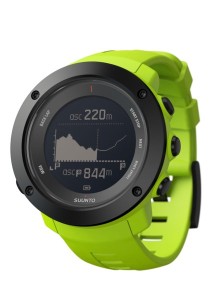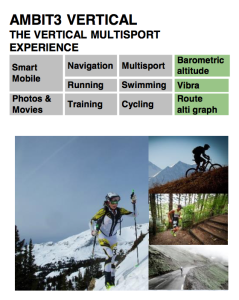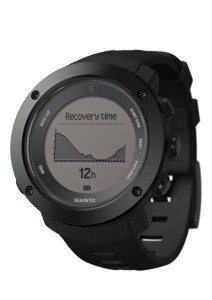Technology moves faster than Kilian on Kilimanjaro. So it’s no surprise then that the New Year brings with it a new Suunto Ambit – this time the “3 Vertical”, with a heads up that in 2016 its all about how high you can get, how fast. Our resident trail tech geek and Associate Editor, Tegyn Angel, received a special preview unit before launch to put the unit through its paces. He also gives a final tip to the word that will soon be on every trail running geek’s lips: STRYD.
 Unboxing the Suunto Ambit 3 Vertical, the first thing I completely failed to notice was the absence of a chunky tumour-like antenna poking out along the band. It’s been such a stalwart feature of previous Ambit watches that it took me nearly two weeks to realise why the watch felt – and looked – so much more refined. Because it’s visually so much simpler, it almost makes it look like a cheaper, lower-end model, though that is hardly the case.
Unboxing the Suunto Ambit 3 Vertical, the first thing I completely failed to notice was the absence of a chunky tumour-like antenna poking out along the band. It’s been such a stalwart feature of previous Ambit watches that it took me nearly two weeks to realise why the watch felt – and looked – so much more refined. Because it’s visually so much simpler, it almost makes it look like a cheaper, lower-end model, though that is hardly the case.
Suunto have developed a completely bezel design that incorporates the antenna, meaning no more bulge and a much more streamlined unit. While aesthetically much nicer, this should also mean a better fit on smaller wrists (i.e. the female half of our population!)
For all intents and purposes, the Vertical looks like a slightly stripped down version of the brand’s flagship, the Ambit 3 Peak. And that’s exactly where it’s positioned: between the Ambit 3 Peak and the Sport. In essence, the Vertical is an updated Peak with half the battery life that presents a handful of new metrics targeted specifically at people who care about their elevation profile. By basing the elevation measurement on barometric pressure the Vertical is able to achieve a far greater degree of accuracy than is possible with the GPS-only Sport and Run models.
 Okay, so it measures elevation more accurately. Is that it? Big deal, go and tell all your Strava buddies. Hold up! Not so fast! Flicking through the watch mode screens (i.e. outside of an activity) you start to get a taste of how the new technical capabilities have been utilised to prevent genuinely relevant information. Screen two presents your 7 day, 30 day and 12 month ascent totals along with your total time climbing.
Okay, so it measures elevation more accurately. Is that it? Big deal, go and tell all your Strava buddies. Hold up! Not so fast! Flicking through the watch mode screens (i.e. outside of an activity) you start to get a taste of how the new technical capabilities have been utilised to prevent genuinely relevant information. Screen two presents your 7 day, 30 day and 12 month ascent totals along with your total time climbing.
However, once you get into an activity mode you start to realise that elevation gain/loss is no longer a trivialised measure of total meters gained or lost per workout. For every activity that records GPS/Altitude data, the watch displays a real-time elevation profile allowing the wearer to better visualise the route so far. While existing Ambit3 models allowed you to pre-program routes online or via the Movescount App and to track your horizontal position visually, the Vertical takes things into the 3rd dimension. The Vertical actually displays an elevation profile of the entire pre-programmed route and tracks your progress on the same with a progressive slider. Very cool!
By themselves, the antenna redesign and vertical functionality are pretty good additions and deliver an update almost as significant as the upgrade from Ambit2 to Ambit3. But Suunto haven’t stopped there. One of the most requested features has finally been included: Vibration! Vibration! Vibration! As seen on the recently released Traverse, button presses now feature haptic feedback and alarms (both time and user-determined alarms like pace, heart rate and so forth) now vibrate. It’s about time! (sorry…). Suunto have also added Recovery and Sleep tests though we’ve yet to test the efficacy of these.
 So should you buy one? As always it depends. If you own an Ambit3 Peak, probably not. I say probably because in the Vertical, Suunto has released a watch that’s positioned below the Peak yet it sports features that the Peak does not. However, if you: own anything else; care about Vert; don’t need a read out of barometric pressure and; don’t plan on running an event that lasts longer than about 10hrs – it’s well worth considering.
So should you buy one? As always it depends. If you own an Ambit3 Peak, probably not. I say probably because in the Vertical, Suunto has released a watch that’s positioned below the Peak yet it sports features that the Peak does not. However, if you: own anything else; care about Vert; don’t need a read out of barometric pressure and; don’t plan on running an event that lasts longer than about 10hrs – it’s well worth considering.
The Vertical is a very solid entry into a crowded market and a definite sign of things to come for Suunto.
Epilogue: What the bloody hell is a Power Meter? Well, apparently they’re the go-to training tool in cycling. According to Wikipedia (yep, that’s how little I knew about them), they “provide an objective measurement of real output that allows training progress to be tracked very simply—something that is more difficult when using, for example, a heart rate monitor alone.” So what? Well, when running at a given pace on a flat, consistent surface (i.e. a road) with no relevant environmental factors (i.e. headwind, snow), heart rate combined is a pretty consistent measure of effort. Fortunately, we’re not road runners (never mind cyclists) and so these factors DO affect any measure of effort.
[You didn’t enter a valid video URL. Please try again.]Until now Power Meters were only readily available for cyclists. Until NOW! Enter stage left, STRYD. The first power meter for runners. While not a Suunto product, Suunto is working very closely with STRYD to ensure that all of their watches are compatible with power meters in all relevant sport modes and that includes running. We haven’t had our test unit long enough to give a thorough review but possibilities are massive.
Let’s look at a quick example: You’re running a trail ultra, lets say the Ultra Trail Australia, and want to pace yourself consistently. Half the course is very hilly, while the other half is pretty fast (according to Sir Kilian). So how do you pace consistently? If you’ve ever looked at your heart rate next to a measure like pace you’ll notice a significant lag between output and BPM. As STRYD put it, “power gives an instant picture of the work input, heart rate shoes how your body reacted to that workload.” By using power as your pacing measure you would be able to pre-establish and monitor a consistent level of output.
It’s an exciting concept! Watch this space.
The Suunto Ambit3 Vertical has a RRP of $629 AUD ($679 AUD with the Suunto Smart Sensor) and is available from the end of January.
For more information, visit www.suunto.com/ambit3vertical.
www.suunto.com www.movescount.com











